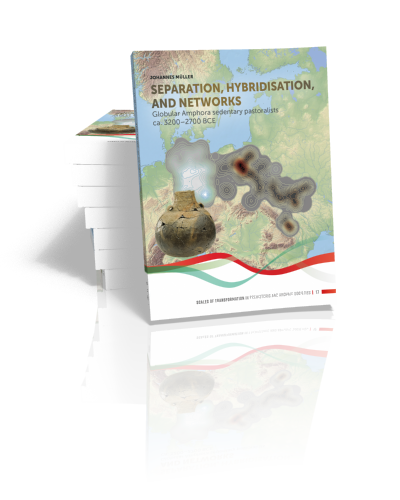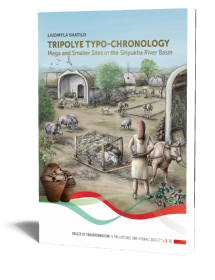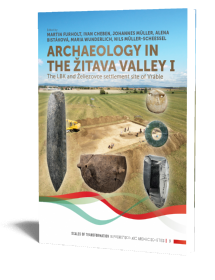Separation, hybridisation, and networks
Globular Amphora sedentary pastoralists ca. 3200-2700 BCE
Johannes Müller | 2023

Separation, hybridisation, and networks
Globular Amphora sedentary pastoralists ca. 3200-2700 BCE
Johannes Müller | 2023
Paperback ISBN: 9789464270488 | Hardback ISBN: 9789464270495 | Imprint: Sidestone Press Academics | Format: 210x280mm | 396 pp. | Scales of Transformation 17 | Series: Scales of Transformation | Language: English | 38 illus. (bw) | 244 illus. (fc) | Keywords: prehistoric archaeology; pottery studies; ceramics; neolithic; globular amphorae; separation; hybridisation; connectivity; transformation | download cover | DOI: 10.59641/a0e4613c
Read online or downloaded 2642 times
-
Digital & Online access
This is a full Open Access publication, click below to buy in print, browse, or download for free.
-
Buy via Sidestone (EU & UK)
-
Buy via our Distributors (WORLD)
For non-EU or UK destinations you can buy our books via our international distributors. Although prices may vary this will ensure speedy delivery and reduction in shipping costs or import tax. But you can also order with us directly via the module above.
UK international distributor
USA international distributor
-
Bookinfo
Paperback ISBN: 9789464270488 | Hardback ISBN: 9789464270495 | Imprint: Sidestone Press Academics | Format: 210x280mm | 396 pp. | Scales of Transformation 17 | Series: Scales of Transformation | Language: English | 38 illus. (bw) | 244 illus. (fc) | Keywords: prehistoric archaeology; pottery studies; ceramics; neolithic; globular amphorae; separation; hybridisation; connectivity; transformation | download cover | DOI: 10.59641/a0e4613c
Read online or downloaded 2642 times

We will plant a tree for each order containing a paperback or hardback book via OneTreePlanted.org.
Around 3000 BCE, a turning point occurred in Europe: Long-existing regional societies entered into a process of transformation. The result is a world in which new global communication networks brought different regions closer together. From 3200/3100 BCE, the Globular Amphora phenomenon (GA) was the trailblazer in Eastern and Central Europe. Due to a focus on pastoral subsistence, in comparison to more agrarian economic systems, new ritual practices formed in light of a more flexible form of settlement. We initially observe the symbolic separation manifested through the “Globular Amphora” in an area between the Lower Vistula and Middle Elbe. Communication networks form rapidly in the West (the Elbe-Network) and in the East (the Vistula-Podolia Network). The monopolisation of the practice of double cattle burials connected regional patterns of mobility in the lowlands between the Elbe and the Dniester.
With the aid of spatial analyses of the systems of symbols (Zeichensysteme) on locally/micro-regionally produced Globular Amphorae, a proxy is developed for the degree of similarity of the GA-habitus in different regions. Bayesian modelling and spatial visualisations of the radiometric dates indicate temporal sequences and synchronic changes within the newly-developed “global” GA-connectivity.
Genetic analyses attest to the indigenous character of the GA individuals in Central Europe. Both isotopic and ceramic technology analyses provide evidence for a mobility radius of up to 50 km for the local groups.
In the main phase of the GA, the Elbe and Vistula-Podolia networks appear separated. In the West the core areas are in Bohemia/Moravia, the Middle Elbe-Saale-Havel area, and the north-western Baltic areas; in the East, they are along the Vistula, in Podolia-Volhynia, and in the Siret area.
GA networks are mostly symbiotically connected with the local and regional agricultural groups. The GA is, among other things, heavily involved in the formation of the multicultural Corded Ware phenomenon. Its end in 2600 BCE is linked to processes of change which also affected the change from Corded Ware to the Bell Beaker phenomenon. Only in the eastern areas, where a strong reciprocal influence with elements from the Steppe existed, can GA still be found until c. 2400 BCE.
The emergence of the GA networks is described as social separation on the basis of social disharmonies within the Funnel Beaker societies, which is also visible via a reduction of the human impact in the palaeoecological archives. A new connectivity of diversified groups developed as a form of levelling mechanism, which in the long-term was part of the transformation of the entirety of European prehistory around 3000 BCE.
Chapter 1. Globular Amphora communities: A matter of connectivity and transformation
1.1 Definitions
1.1.1 Transformation
1.1.2 Connectivity and globalisation
1.1.3 Mobility
1.1.4 Habitus
1.2 Globular Amphora perspectives
1.2.1 Globular Amphorae and globalisation
1.2.2 Globular Amphorae and separation: Identity construction?
1.2.3 Globular Amphorae: Translocation and networks
1.3 Methods
1.4 Integration into previous research
1.4.1 Regional and trans-regional studies
1.4.2 Chronologies
1.4.3 Settlement patterns and economy
1.4.4 Graves
1.4.5 Distribution model
1.5 Distribution space and landscape
Chapter 2. Space and Decoration: Patterns of globular amphorae
2.1 Research questions and methodology: General comments
2.1.1 Research questions
2.1.2 Methods
2.1.3 Sources
2.2 The database: Recorded ceramic finds
2.3 Investigations of vessel forms
2.3.1 Vessel types and individual observations
2.3.2 Vessel types: univariate and multivariate analyses
2.3.3 Results and interpretation
2.4 Investigations on decoration techniques
2.4.1 Decoration techniques and individual observations
2.4.2 Correspondence analysis and spatial distribution of decoration techniques
2.4.3 Results and interpretation
2.5 Investigations on decoration motifs
2.5.1 Decoration motifs and individual observations
2.5.2 Decoration motifs: univariate and multivariate analyses
2.5.3 Results and interpretation
2.6 Comprehensive analysis
2.6.1 Multivariate description of Globular Amphora ceramics
2.6.2 Interpretation
Chapter 3. Absolute chronological dating of the Globular Amphora phenomenon
3.1 Methodological procedure
3.1.1 Approach
3.2 The database
3.3 Regional investigations with Bayesian datings
3.3.1 Western GAC
3.3.2 The Central GAC
3.3.3 Eastern GAC
3.4 Overall results of Bayesian dating
3.4.1 Beginning
3.4.2 Decoration change
3.4.3 Disappearance
3.4.4 Modeling
3.4.5 Interpretation: Spatial distribution pattern
3.5 Overall consideration of the individual radiometric datings
3.5.1 Mapping of the individual 14C data
3.5.2 Spatial-temporal distribution according to hexagonal surfaces
3.6 Summary and consequences
Chapter 4. The Middle Elbe-Saale region: A mosaic of diverse cultural and social practices around 3000 BCE
4.1 The Central German Bernburg culture: Chronology and interpretation
4.1.1 Basic chronological trends
4.1.2 Chronology of the graves
4.1.3 Chronology of the chamber graves
4.1.4 Chronology of the settlement pits
4.1.5 Overall result: The chronology of a ceramic style
4.1.6 Interpretation: The Bernburg style in the multicultural environment of the Central German Late Neolithic
4.2. The Central German Globular Amphora culture: Chronology and interpretation
4.3 Economy and settlement patterns: A complex mosaic
4.3.1 Bernburg subsistence economy
4.3.2 Settlement distribution
4.3.3 Settlement types
4.3.4 Pit huts, posts and houses
4.3.5 Settlement patterns and chronology
4.4 Patrilocality and admixture
4.5 Consequences: Symbiotic relationships
4.6 A Western GAC pattern?
4.7 Conclusions
Chapter 5. Environment, economy and nutrition of the Globular Amphora communities
5.1 The environment of the GAC
5.1.1 Geomorphology and pedology
5.1.2 Vegetation and vegetation changes
5.1.3 Summary
5.2 Economic data from the Western GAC
5.2.1 Central Germany and the Southwest Baltic regions
5.2.2 Bohemia/Moravia
5.3 Economic data from Kuyavia and Lesser Poland
5.3.1 Flint raw material supply and equipment use
5.3.2 Examples of local economies: Rocks, Janowice and Wilostowo
5.3.3 Summary
5.4 Eastern Globular Amphorae
5.5 Overall interpretation
Chapter 6. Discernible domestic activities: Settlement patterns
6.1 Western GAC
6.1.1 Central Germany and Northwest Germany
6.1.2 Bohemia/Moravia
6.2 Central Group
6.3 Summary and interpretation
6.4 Spatial patterning of GAC domestic sites
Chapter 7. Scales of Mobility: The historical dimension of the Globular Amphora phenomenon
7.1 Kinship and ancestry of GAC individuals: The database
7.2 Genetic continuities between Middle and Late Neolithic Groups and the GAC
7.3 Regional variances
7.3.1 Western Germany
7.3.2 Middle Elbe-Saale region
7.3.3 Bohemia
7.3.4 Northern Poland
7.3.5 Lesser Poland
7.3.6 Western Ukraine
7.4 The Central European Globular Amphora culture and the emergence of the Corded Ware culture
7.5 Kinship structures and marriage practices
7.6 Scales of sedentism and mobility of a phenomenon with new ritual practices: The Globular Amphora Culture
Chapter 8. Separation and hybridisation on a global scale: The Globular Amphora networks
8.1 A model
References

Prof. dr. Johannes Müller
Johannes Müller (PhD, University of Freiburg, 1990) is a Professor and Director of the Institute for Prehistoric and Protohistoric Archaeology at Kiel University, Germany. He is the founding director of the Johanna Mestorf Academy, Speaker of the Collaborative Research Centre “Scales of Transformation: Human-environmental Interaction in Prehistoric and Archaic Societies”and of the Excellence Cluster “ROOTS – Social, Environmental, and Cultural Connectivity in Past Societies”.
Abstract:
Around 3000 BCE, a turning point occurred in Europe: Long-existing regional societies entered into a process of transformation. The result is a world in which new global communication networks brought different regions closer together. From 3200/3100 BCE, the Globular Amphora phenomenon (GA) was the trailblazer in Eastern and Central Europe. Due to a focus on pastoral subsistence, in comparison to more agrarian economic systems, new ritual practices formed in light of a more flexible form of settlement. We initially observe the symbolic separation manifested through the “Globular Amphora” in an area between the Lower Vistula and Middle Elbe. Communication networks form rapidly in the West (the Elbe-Network) and in the East (the Vistula-Podolia Network). The monopolisation of the practice of double cattle burials connected regional patterns of mobility in the lowlands between the Elbe and the Dniester.
With the aid of spatial analyses of the systems of symbols (Zeichensysteme) on locally/micro-regionally produced Globular Amphorae, a proxy is developed for the degree of similarity of the GA-habitus in different regions. Bayesian modelling and spatial visualisations of the radiometric dates indicate temporal sequences and synchronic changes within the newly-developed “global” GA-connectivity.
Genetic analyses attest to the indigenous character of the GA individuals in Central Europe. Both isotopic and ceramic technology analyses provide evidence for a mobility radius of up to 50 km for the local groups.
In the main phase of the GA, the Elbe and Vistula-Podolia networks appear separated. In the West the core areas are in Bohemia/Moravia, the Middle Elbe-Saale-Havel area, and the north-western Baltic areas; in the East, they are along the Vistula, in Podolia-Volhynia, and in the Siret area.
GA networks are mostly symbiotically connected with the local and regional agricultural groups. The GA is, among other things, heavily involved in the formation of the multicultural Corded Ware phenomenon. Its end in 2600 BCE is linked to processes of change which also affected the change from Corded Ware to the Bell Beaker phenomenon. Only in the eastern areas, where a strong reciprocal influence with elements from the Steppe existed, can GA still be found until c. 2400 BCE.
The emergence of the GA networks is described as social separation on the basis of social disharmonies within the Funnel Beaker societies, which is also visible via a reduction of the human impact in the palaeoecological archives. A new connectivity of diversified groups developed as a form of levelling mechanism, which in the long-term was part of the transformation of the entirety of European prehistory around 3000 BCE.
Contents
Chapter 1. Globular Amphora communities: A matter of connectivity and transformation
1.1 Definitions
1.1.1 Transformation
1.1.2 Connectivity and globalisation
1.1.3 Mobility
1.1.4 Habitus
1.2 Globular Amphora perspectives
1.2.1 Globular Amphorae and globalisation
1.2.2 Globular Amphorae and separation: Identity construction?
1.2.3 Globular Amphorae: Translocation and networks
1.3 Methods
1.4 Integration into previous research
1.4.1 Regional and trans-regional studies
1.4.2 Chronologies
1.4.3 Settlement patterns and economy
1.4.4 Graves
1.4.5 Distribution model
1.5 Distribution space and landscape
Chapter 2. Space and Decoration: Patterns of globular amphorae
2.1 Research questions and methodology: General comments
2.1.1 Research questions
2.1.2 Methods
2.1.3 Sources
2.2 The database: Recorded ceramic finds
2.3 Investigations of vessel forms
2.3.1 Vessel types and individual observations
2.3.2 Vessel types: univariate and multivariate analyses
2.3.3 Results and interpretation
2.4 Investigations on decoration techniques
2.4.1 Decoration techniques and individual observations
2.4.2 Correspondence analysis and spatial distribution of decoration techniques
2.4.3 Results and interpretation
2.5 Investigations on decoration motifs
2.5.1 Decoration motifs and individual observations
2.5.2 Decoration motifs: univariate and multivariate analyses
2.5.3 Results and interpretation
2.6 Comprehensive analysis
2.6.1 Multivariate description of Globular Amphora ceramics
2.6.2 Interpretation
Chapter 3. Absolute chronological dating of the Globular Amphora phenomenon
3.1 Methodological procedure
3.1.1 Approach
3.2 The database
3.3 Regional investigations with Bayesian datings
3.3.1 Western GAC
3.3.2 The Central GAC
3.3.3 Eastern GAC
3.4 Overall results of Bayesian dating
3.4.1 Beginning
3.4.2 Decoration change
3.4.3 Disappearance
3.4.4 Modeling
3.4.5 Interpretation: Spatial distribution pattern
3.5 Overall consideration of the individual radiometric datings
3.5.1 Mapping of the individual 14C data
3.5.2 Spatial-temporal distribution according to hexagonal surfaces
3.6 Summary and consequences
Chapter 4. The Middle Elbe-Saale region: A mosaic of diverse cultural and social practices around 3000 BCE
4.1 The Central German Bernburg culture: Chronology and interpretation
4.1.1 Basic chronological trends
4.1.2 Chronology of the graves
4.1.3 Chronology of the chamber graves
4.1.4 Chronology of the settlement pits
4.1.5 Overall result: The chronology of a ceramic style
4.1.6 Interpretation: The Bernburg style in the multicultural environment of the Central German Late Neolithic
4.2. The Central German Globular Amphora culture: Chronology and interpretation
4.3 Economy and settlement patterns: A complex mosaic
4.3.1 Bernburg subsistence economy
4.3.2 Settlement distribution
4.3.3 Settlement types
4.3.4 Pit huts, posts and houses
4.3.5 Settlement patterns and chronology
4.4 Patrilocality and admixture
4.5 Consequences: Symbiotic relationships
4.6 A Western GAC pattern?
4.7 Conclusions
Chapter 5. Environment, economy and nutrition of the Globular Amphora communities
5.1 The environment of the GAC
5.1.1 Geomorphology and pedology
5.1.2 Vegetation and vegetation changes
5.1.3 Summary
5.2 Economic data from the Western GAC
5.2.1 Central Germany and the Southwest Baltic regions
5.2.2 Bohemia/Moravia
5.3 Economic data from Kuyavia and Lesser Poland
5.3.1 Flint raw material supply and equipment use
5.3.2 Examples of local economies: Rocks, Janowice and Wilostowo
5.3.3 Summary
5.4 Eastern Globular Amphorae
5.5 Overall interpretation
Chapter 6. Discernible domestic activities: Settlement patterns
6.1 Western GAC
6.1.1 Central Germany and Northwest Germany
6.1.2 Bohemia/Moravia
6.2 Central Group
6.3 Summary and interpretation
6.4 Spatial patterning of GAC domestic sites
Chapter 7. Scales of Mobility: The historical dimension of the Globular Amphora phenomenon
7.1 Kinship and ancestry of GAC individuals: The database
7.2 Genetic continuities between Middle and Late Neolithic Groups and the GAC
7.3 Regional variances
7.3.1 Western Germany
7.3.2 Middle Elbe-Saale region
7.3.3 Bohemia
7.3.4 Northern Poland
7.3.5 Lesser Poland
7.3.6 Western Ukraine
7.4 The Central European Globular Amphora culture and the emergence of the Corded Ware culture
7.5 Kinship structures and marriage practices
7.6 Scales of sedentism and mobility of a phenomenon with new ritual practices: The Globular Amphora Culture
Chapter 8. Separation and hybridisation on a global scale: The Globular Amphora networks
8.1 A model
References

Prof. dr. Johannes Müller
Johannes Müller (PhD, University of Freiburg, 1990) is a Professor and Director of the Institute for Prehistoric and Protohistoric Archaeology at Kiel University, Germany. He is the founding director of the Johanna Mestorf Academy, Speaker of the Collaborative Research Centre “Scales of Transformation: Human-environmental Interaction in Prehistoric and Archaic Societies”and of the Excellence Cluster “ROOTS – Social, Environmental, and Cultural Connectivity in Past Societies”.
-
Digital & Online access
This is a full Open Access publication, click below to buy in print, browse, or download for free.
-
Buy via Sidestone (EU & UK)
-
Buy via our Distributors (WORLD)
For non-EU or UK destinations you can buy our books via our international distributors. Although prices may vary this will ensure speedy delivery and reduction in shipping costs or import tax. But you can also order with us directly via the module above.
UK international distributor
USA international distributor
- Browse all books by subject
-
Search all books

We will plant a tree for each order containing a paperback or hardback book via OneTreePlanted.org.
You might also like:
© 2026 Sidestone Press KvK nr. 28114891 Privacy policy Sidestone Newsletter Terms and Conditions (Dutch)








